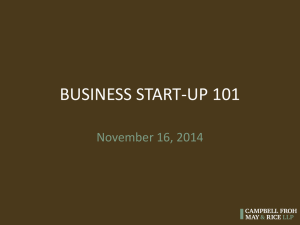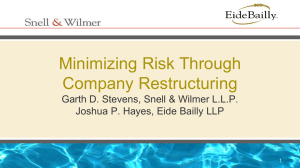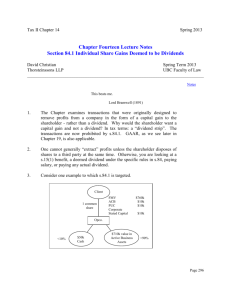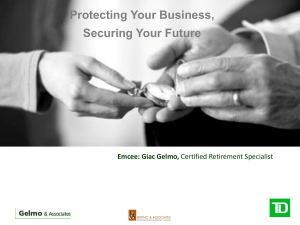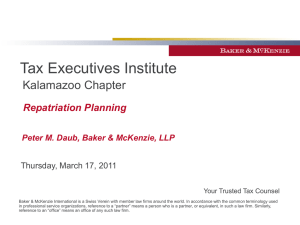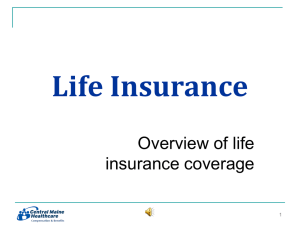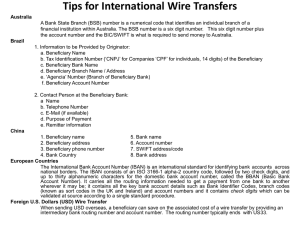Canada Life - BRIDGEFORCE
advertisement
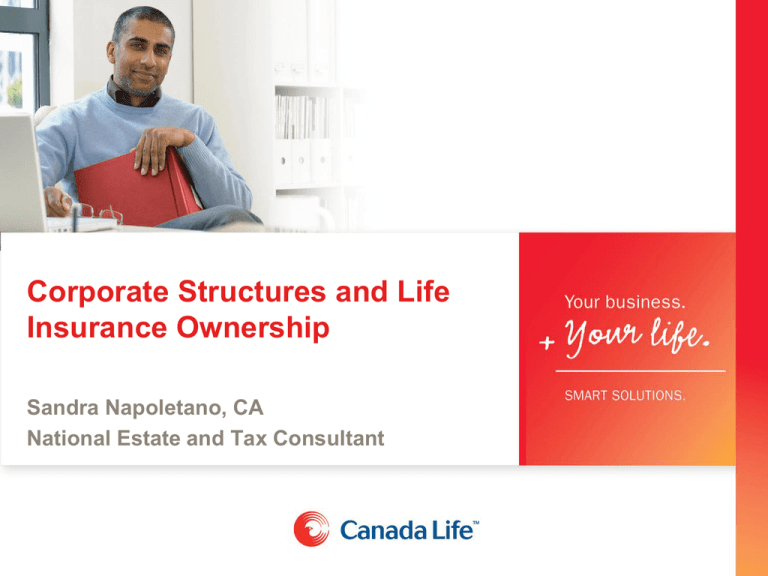
Corporate Structures and Life Insurance Ownership Sandra Napoletano, CA National Estate and Tax Consultant Important Information The information provided is based on current tax legislation and interpretations for Canadian residents and is accurate to the best of our knowledge as of the date of publication. Future changes to tax legislation and interpretations may affect this information. This information is general in nature, and is not intended to be legal or tax advice. For specific situations, you should consult the appropriate legal, accounting or tax advisor. 2 Update: 2013 Tax Rates Corporate tax rate (Ont.) 2013 > $500,000 active business income 26.5% < $500,000 active business income 15.5% Personal top marginal rate > $509,000 49.53% Personal top marginal salary rate 46.41% Immediate deferral > $500,000 active business income 23.03% < $500,000 active business income 30.91% 3 2013 Federal Budget Proposals • Capital gains exemption will increase to $800,000 from $750,000 starting Jan. 1, 2014 • Tax rate on non-eligible dividends increases to 34.21% at top marginal rate and 38.11% if income > $509,0000 (starting Jan. 1, 2014) • 2013 top marginal rate on non-eligible dividends is 32.57% and 36.47% if income > $509,000 4 Benefits of Income Tax Deferral: • Business expense are less expensive than if paid personally • Insurance is less expensive, therefore client can afford more coverage • Less taxes paid upfront allows for cash/wealth accumulation at a faster rate than income earned personally 5 Cost Effectiveness of Using Corp. Dollars Consider the payment of a life insurance premium which is generally not deductible. Assuming a $20,000 annual premium. Sole Proprietor Premium Less personal tax (e.g. 46.41%) $20,000 $17,313 Pre-Tax Income Needed $37,313 Less corporate tax (e.g.15.5%) Corporation $20,000 $3,669 $23,669 Before tax income needed to pay the life insurance premium 6 Typical Client Situation Your client owns a corporation earning active business income and there is a need for insurance. Issues: • • • • Who should be the owner and beneficiary of the policy? Who should pay the premiums? Can designate a beneficiary different from owner of the policy Beware of CRA’s assessing position (in 2010) for situations where corporate owner and beneficiary are not the same Answers: Depends on client’s objectives and their fact situation 7 Typical Client Mr. X 100% XYZ Co. • Mr.X’s wealth is all tied up in XYZ Co. • Mr. X wants to preserve wealth for his family on his death • Insurance will provide the financial security to cover income taxes at death and estate preservation for his family • Creditor protection is a concern 8 XYZ Co. owns the policy and Mr. X is designated beneficiary Mr. X XYZ Co. - Beneficiary - Owns policy and pays premiums • This structure keeps the policy’s value out of the hands of Mr.X’s personal creditors • CSV becomes XYZ’s asset and can be seized • Not the most tax effective structure because CRA will assess section 15(1) shareholder benefit in Mr. X’s income for amount of premiums • Bad result because there will be double tax 9 XYZ Co is Owner & Beneficiary Mr. X XYZ Co. - Owns policy, pays premiums and is the beneficiary • Life insurance policy is exposed to XYZ Co’s creditors • CSV may put XYZ Co offside for CGE & QSBCS status • Alternative owner for policy? 10 Set up a Holdco Mr. X 100% Holdco 100% XYZ Co. • Transfer of XYZ Co can be done on a tax-deferred basis therefore no immediate tax consequences to Mr. X 11 Benefits of Owning Opco Through Holdco • Dividend planning • Creditor protection of corporate profits • Income splitting and succession planning • Purify Opco to maintain QSBC status 12 Holdco owns Policy & Opco is Beneficiary Mr. X Holdco Opco - Owns the policy and pays premiums - Designated revocable beneficiary • This structure is implemented to provide creditor protection for the policy while the life insured is alive • Avoids tax on disposition should Opco be sold and Holdco wants to retain ownership of the policy • CRA made comments that s.15(1) shareholder benefit will not apply but s. 246(1) benefit could apply 13 What if Opco Reimburses Premiums to Holdco? • Tax-free dividends can be paid from Opco to Holdco equal to premiums paid • CRA has commented that there will be no 15(1) benefit to the extent Opco’s reimbursement of premium is included in Holdco’s income under section 9 or 12(1)(x) of the Act • Not optimal since results in double tax !!! 14 Holdco is Owner & Beneficiary Mr. X - Owner, pays premium & beneficiary Holdco Opco • Creditor protection concern is addressed • No future disposition of policy required if Opco is sold 15 Sister Corporations Mr. X 100% Owner of policy & pays premiums 100% Sister Co 1 Sister Co 2 - beneficiary • SisterCo 2 reimburses SisterCo 1 for the premiums paid • CRA comments are the same as Opco reimbursing Holdco for the premiums • Results in double tax • Solution is to insert a Holdco 16 Sister Corporations cont’d Mr. X Holdco - owns policy & beneficiary 100% 100% SisterCo 1 SisterCo 2 17 CRA’s Views & Comments • CRA is concerned with the ability of a corporation to avoid having the ACB of a policy grind the CDA credit by having the death benefit paid to a different corporate entity. • It is therefore very important to be able to demonstrate a bonafide business reason for separating the ownership and beneficiary designation between two corporate entities. • CRA stated it will closely review any situation where a corporate beneficiary of the policy is different than the corporate owner and the corporations are under common control. 18 Capital Gains Exemption Mr. X 100% Holdco 100% Opco • Mr. X is now concerned with his ability to use his CGE now that Opco has grown in value through profit retention and accumulated non–business assets 19 Capital Gains Exemption cont’d • No tax incentive excites the interest of an owner of a small or medium sized business more than the $750,000 lifetime capital gains exemption • Tax savings of $174,000 per individual shareholder • 2013 Federal budget announced proposals to increase exemption to $800,000 for potential tax savings of $198,000 for disposition of shares after 2013 • Applies to capital gains realized on disposition of qualified small business corporation share (“QSBCS”) if strict criteria is met 20 The share is a share of a small business corporation (“SBC”) 1. At the time of disposition 90% or more of the fair market value of the assets is attributable to assets; i. ii. iii. Used in an active business carried on primarily (more than 50%) in Canada Shares or debt of one or more SBC that are connected to the corporation, or A combination of i. and ii. 21 Capital Gains Exemption cont’d 2. The share was not owned by anyone other than the individual or a person or partnership related to the individual throughout the 24 months preceding the disposition 3. Throughout the 24 months preceding the disposition, the share was owned by the individual or a person or partnership related to the individual & more than 50% of the fair market value of the assets are attributable to types of property relevant for the SBC definition Anti-stacking stringent rule imposes 50% to be 90% for Opco 22 Common Corporate Structure Mr. X 100% Insurance policy Holdco 100% XYZ Co • This structure works for creditor proofing XYZ Co • Creates complications to access capital gains exemption i. Mr. X needs to sell share of Holdco ii. Buyer wants XYZ Co not Holdco 23 Triangle Structure Mr. X 100% 99% Class A shares Holdco 1% Insurance policy Class B shares XYZ Co • Excess cash is paid on a regular and continuous basis as a tax-free dividend to Holdco to the exclusion of Mr. X (assumes no RDTOH in XYZ Co) • Opco stays “pure” to meet QSBCS status • Substantially all the value of Opco rests with Mr. X to use his CGE on a sale or death • 1% FMV held by Holdco so lose ability to use CGE • What if value of XYZ Co is greater than $750,000? (or $800,000 starting January 1, 2014) 24 Corporate Beneficiary Structure Mr. X Mrs. X Son Daughter (Beneficiaries) Family Trust Mr. X $750,000 freeze shares Common Shares XYZ Co 25 Holdco Corporate Beneficiary Structure cont’d • Excess cash in XYZ Co is paid on a regular and continuous basis as dividends to the Family Trust • Trust is a taxpayer for income tax purposes • Trust pays tax on income not allocated to beneficiaries • Trust can allocate dividends and capital gains to beneficiaries which retain their character • Trust pays no tax if all income is allocated to beneficiaries • Allows XYZ Co to stay “pure” 26 Corporate Beneficiary Structure cont’d • Allows CGE to be multiplied so that each individual beneficiary can be allocated up to $750,000 capital gains • Holdco must be connected with XYZ Co to receive tax-fee dividends (extended definition of “control” in the Act) • Complications may arise when arms length shareholders are involved • $750,000 x 4 individual shareholders = $3M of capital gain sheltered or $696,000 income tax savings on future sale of XYZ Co 27 Using CDA in an Insurance Financed Promissory Note (P/N) Buyout Mr. B Estate Mr. A 50% 50% Opco - Insurance policy • Mr. A and Mr. B are partners • Mr. A dies • Shareholders Agreement stipulates shares owned by Mr. A are to be sold to Mr. B after death • Buyout is funded with life insurance proceeds 28 Buyout with Insurance Financed P/N cont’d Step 1: • Mr. B buys shares from the Estate of Mr. A at FMV for a promissory note Step 2: • Opco declares a capital dividend to Mr. B who uses the proceeds to repay the promissory note to the Estate 29 Insert Holdco to Preserve CDA Mr. B Estate Mr. A Holdco 50% 50% Opco - Insurance policy 30 CDA Preservation with Holdco cont’d Step 1: • Mr. B transfers his shares to a newly incorporated Holdco on a tax deferred basis Step 2: • Holdco buys the shares of a Opco from the Estate of Mr. A at FMV for a promissory note Step 3: • Opco declares a capital dividend to Holdco equal to life insurance proceeds received Step 4: • Holdco uses the proceeds to repay promissory note to Estate of Mr. A 31 CDA Preservation with Holdco cont’d Mr. B Holdco 100% Opco • Mr. B will have to sell Holdco to utilize CGE, if Holdco is a QSBCS • Can reorganize to crystallize CGE 32 CDA Preservation with Holdco cont’d • Holdco’s capital dividend account is increased by amount of capital dividends received by Opco • Paying down promissory note does not reduce CDA balance • Future retained earnings and value of Holdco can be paid out tax-free via CDA of Holdco to Mr. B • Capital dividend anti-avoidance rules to consider 33 Preserve CDA and Utilize CGE Mr. B Estate Mr. A Mr. B FMV = $750,000 Holdco 50% 50% common shares Opco • Allows Mr. B to get bump in ACB by crystallizing CGE • Holdco will buy out 50% from Estate of Mr. A for a note • Assumes Opco’s FMV is $1.5M 34 Preserve CDA and Multiple CGE Mr. B, Spouse & Children (beneficiaries) Holdco Mr. B FMV = $750,000 preference Estate Mr. A Mr. B Family Trust 50% 50% common shares Opco • • • • Beneficiaries can now utilize CGE on future sale of Opco Trust uses insurances proceeds to buy shares from Mr. A’s Estate Holdco’s CDA increased via Trust’s capital dividend declared Holdco pays out future dividends which would otherwise be taxable 35 National Estate and Tax Planning Team Ontario Regional Marketing Centre Resources • Contact your Canada Life marketing consultant to access your local national estate and tax planning team: – Bryan McNulty, LL.B. – Steven McLeod, LL.B. – Sandra Napoletano, CA. 36 Questions? Thank you 37
